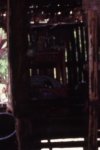I've been scanning slides for an upcoming article and have been using Photoshop CS. I have been using version 6 for years and like it a lot, but the new CS version has a tool in it that makes me never want to look back.
When I took the photos, I used ISO 400 slide film- I believe it was Sensia II.
This is not my film of choice, but in this case, I wanted the extra couple of stops available so that I could hand-hold the camera and get reasonably sharp images. I was in a very remote location, this was only going to happen once, with no possibility for going back and getting a second chance shot.
When I got the slides back, I had mixed results. Many were too contrasty- ok for projection, but not for scanning. The highlights were often blown out with little to no information in them, and there was very little detail that could be seen in the shadows.
I had scanned a few before and had worked on them months ago using my decent level of Photoshop skills, but I was never really satisfied with the results.
Photoshop CS has a new (I believe- Never used version 7) feature called 'Shadows and Highlights'. The work that this filter can do is absolutly amazing. It can pull information deep out of the shadows and make it visible, as well as give information back in the highlights. I've been able to reconstruct cloudy skies (which appeared almost solid white) as well as pull detail out of shadows so dark, you'd never think anything was there.
The key is playing around with the settings. I've found that many times, using about 15 on both shadows and highlights will even out the contrast to a very acceptable level. On dark slides, using shadows at 25-35 will help quite a bit without drastically affecting the overall quality of the image.
I'm hooked- This little feature has already saved me hours of tedious and frustrating work that would have been difficult to do in earlier versions of PhotoShop.
Regards.
Mike Kirda
When I took the photos, I used ISO 400 slide film- I believe it was Sensia II.
This is not my film of choice, but in this case, I wanted the extra couple of stops available so that I could hand-hold the camera and get reasonably sharp images. I was in a very remote location, this was only going to happen once, with no possibility for going back and getting a second chance shot.
When I got the slides back, I had mixed results. Many were too contrasty- ok for projection, but not for scanning. The highlights were often blown out with little to no information in them, and there was very little detail that could be seen in the shadows.
I had scanned a few before and had worked on them months ago using my decent level of Photoshop skills, but I was never really satisfied with the results.
Photoshop CS has a new (I believe- Never used version 7) feature called 'Shadows and Highlights'. The work that this filter can do is absolutly amazing. It can pull information deep out of the shadows and make it visible, as well as give information back in the highlights. I've been able to reconstruct cloudy skies (which appeared almost solid white) as well as pull detail out of shadows so dark, you'd never think anything was there.
The key is playing around with the settings. I've found that many times, using about 15 on both shadows and highlights will even out the contrast to a very acceptable level. On dark slides, using shadows at 25-35 will help quite a bit without drastically affecting the overall quality of the image.
I'm hooked- This little feature has already saved me hours of tedious and frustrating work that would have been difficult to do in earlier versions of PhotoShop.
Regards.
Mike Kirda









